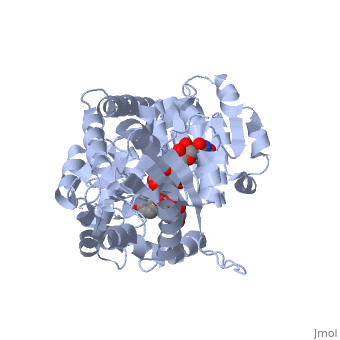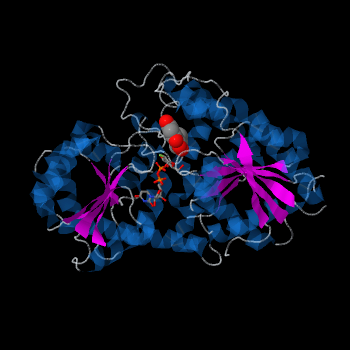Vitis vinifera Flavonoid 3-O-Glucosyltransferase (Vv3GT)
From Proteopedia
(Difference between revisions)
| Line 3: | Line 3: | ||
== Introduction == | == Introduction == | ||
| - | Vv3GT belongs to Glycosyltransferases (GTs), a large family of enzymes involved in the transfer of sugar residues from a sugar donor to various substrates. Glycosylation of metabolites in plants is usually catalyzed by glycosyltransferases (GTs) belonging to the GT1 sub-family (as classified by the CAZy database [http://www.cazy.org], which use UDP-activated sugars as the major donor molecule and are thus referred to as UGTs. The Glycosyltransferase activity is highly important for the synthesis of thousands of plant metabolites. This enzymes differ in their specificity for substrate, position of glycosylation on the substrate and recognition of sugar donor. These differences are important and could affect the function and stability of the metabolite. A good example for the importance of glycosyltransferase specificity is shown in Citrus. the difference in the position of glycosylation affects fruit flavor. Glycosylation of one position lids to the synthesis of bitter substances while the addition of same molecule at a different position lids to the synthesis of tasteless substances. | + | Vv3GT belongs to Glycosyltransferases (GTs), a large family of enzymes involved in the transfer of sugar residues from a sugar donor to various substrates. Glycosylation of metabolites in plants is usually catalyzed by glycosyltransferases (GTs) belonging to the GT1 sub-family (as classified by the CAZy database [http://www.cazy.org], which use UDP-activated sugars as the major donor molecule and are thus referred to as UGTs. The Glycosyltransferase activity is highly important for the synthesis of thousands of plant metabolites. This enzymes differ in their specificity for substrate, position of glycosylation on the substrate and recognition of sugar donor. These differences are important and could affect the function and stability of the metabolite. A good example for the importance of glycosyltransferase specificity is shown in Citrus <ref>PMID:15361143</ref> . the difference in the position of glycosylation affects fruit flavor. Glycosylation of one position lids to the synthesis of bitter substances while the addition of same molecule at a different position lids to the synthesis of tasteless substances. |
| Line 11: | Line 11: | ||
== Structural highlights == | == Structural highlights == | ||
| - | Despite low primary sequence similarity, the secondary and tertiary structures of GTs are highly conserved. <ref>PMID: | + | Despite low primary sequence similarity, the secondary and tertiary structures of GTs are highly conserved. <ref>PMID:18829982</ref> |
=== GT-B === | === GT-B === | ||
| - | Plant glycosyltransferases assume one of two folds, GT-A or GT-B. Vv3GT is a GT-B enzyme. GT-B enzymes consists of two β/α/β Rossmann-like domains. The two domains are associated and face each other with the active-site lying between them. These domains are associated with the donor and acceptor substrate binding sites. | + | Plant glycosyltransferases assume one of two folds, GT-A or GT-B. Vv3GT is a GT-B enzyme.<ref>PMID:18829982</ref> GT-B enzymes consists of two β/α/β Rossmann-like domains. The two domains are associated and face each other with the active-site lying between them. These domains are associated with the donor and acceptor substrate binding sites. |
The <scene name='69/692252/2c1z_rainbow/1'>N-terminal and C-terminal domain</scene>, linked by a flexible loop and α-helix with a hinge region. The linker could be important for sugar donor binding. This linker region holds the UDP-sugar donor next to the C-terminal PSPG motif. The C-terminal domain is highly conserved and binds the UDP sugar donor (e. g. UDP-Glc). On the other hand, the N-terminal domain is not conserved it binds the substrate and provides catalytically active amino acids. | The <scene name='69/692252/2c1z_rainbow/1'>N-terminal and C-terminal domain</scene>, linked by a flexible loop and α-helix with a hinge region. The linker could be important for sugar donor binding. This linker region holds the UDP-sugar donor next to the C-terminal PSPG motif. The C-terminal domain is highly conserved and binds the UDP sugar donor (e. g. UDP-Glc). On the other hand, the N-terminal domain is not conserved it binds the substrate and provides catalytically active amino acids. | ||
| Line 40: | Line 40: | ||
== References == | == References == | ||
| - | 1. Frydman A, Weisshaus O, Bar-Peled M, Huhman DV, Sumner LW, Marin FR, Lewinsohn E, Fluhr R, Gressel J and Eyal Y (2004) Citrus fruit bitter flavors: Isolation and functional characterization of the gene Cm1,2RhaT encoding a 1,2 rhamnosyltransferase, a key enzyme in the biosynthesis of the bitter flavonoids of citrus. Plant J. 40: 88-100. | ||
| - | |||
| - | 2. Offen W, Martinez-Fleites C, Yang M, Lim EK, Davis BG, Tarling CA, Ford CM, Bowles DJ, Davies GJ (2006) Structure of a flavonoid glucosyltransferase reveals the basis for plant natural product modification. EMBO 25: 1396-1405. | ||
| - | |||
| - | 3. Osmani SA, Bak S, Møller BL (2009) Substrate specificity of plant UDP-dependent glycosyltransferases predicted from crystal structures and homology modeling. Phytochemistry 70: 325-347. | ||
Revision as of 10:28, 25 January 2015
| |||||||||||


